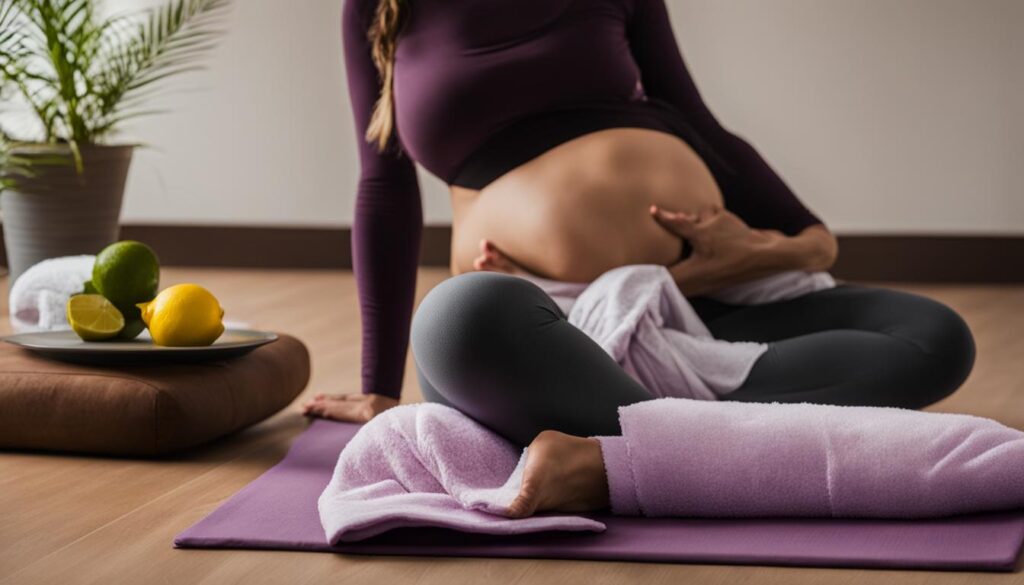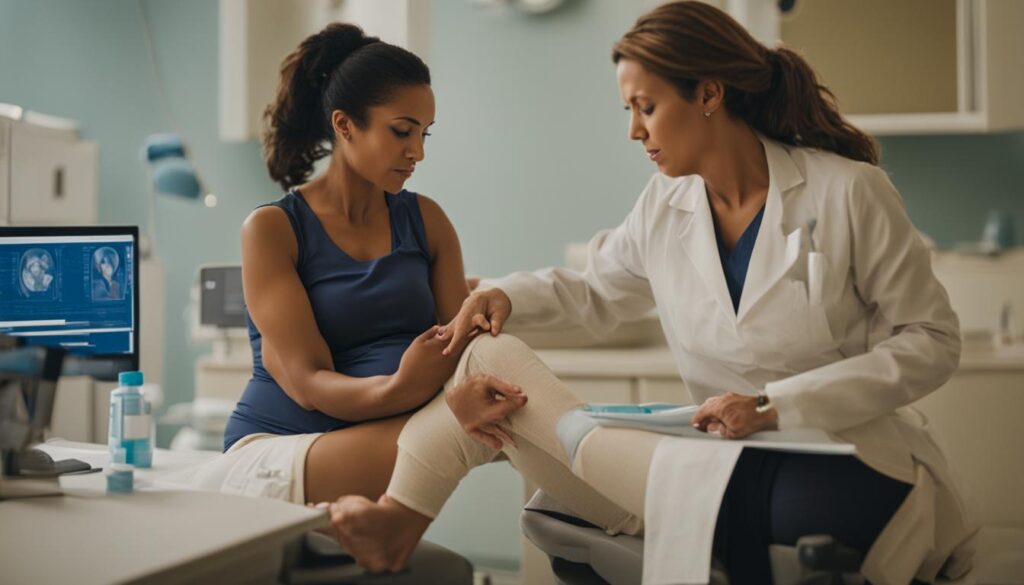Leg cramps are a common occurrence in pregnant women, especially during the second and third trimesters. Many expectant mothers experience leg cramps, which can be uncomfortable and disruptive to their daily activities. Understanding the frequency of leg cramps during pregnancy is essential for managing and preventing these episodes.
During pregnancy, the exact cause of leg cramps remains unclear. However, several factors may contribute to their occurrence. Changes in blood circulation, increased pressure on leg muscles due to the growing baby, and alterations in calcium levels are believed to play a role in the frequency of leg cramps in pregnancy.
While leg cramps can vary from woman to woman, they often become more prevalent as pregnancy progresses. Hormonal changes and the expanding uterus can contribute to muscle contractions and tightness, leading to leg cramps. These cramps are most commonly experienced in the calves but can also occur in the thighs or feet.
Managing leg cramps during pregnancy involves implementing preventive measures and adopting strategies that can provide relief when cramps occur. By understanding the frequency of leg cramps and employing effective techniques, expectant mothers can minimize discomfort and maintain their well-being throughout their pregnancy journey.
Key Takeaways:
- Leg cramps are a common occurrence during pregnancy, particularly in the second and third trimesters.
- The exact cause of leg cramps in pregnant women is unclear, but changes in blood circulation, increased pressure on leg muscles, and alterations in calcium levels may contribute to their frequency.
- Stretching, staying active, staying hydrated, and ensuring an adequate intake of calcium and magnesium are important preventive measures for managing leg cramps during pregnancy.
- Techniques such as stretching, massaging, applying heat packs, and taking paracetamol can provide relief when experiencing leg cramps.
- Seeking medical help is necessary if leg cramps are accompanied by swelling, tenderness, redness, or warmth, or if there is persistent or severe leg pain.
Causes of Leg Cramps During Pregnancy
The exact causes of leg cramps during pregnancy are unknown. However, it is believed that several factors contribute to their occurrence.
- Changes in blood circulation: During pregnancy, there is an increase in blood volume and the production of hormones that can affect blood flow. These changes may lead to reduced circulation in the legs, contributing to muscle cramps.
- Increased pressure on leg muscles: As the baby grows, it puts pressure on the blood vessels and nerves in the pelvis and legs. This added pressure can lead to muscle contractions and leg cramps.
- Changes in calcium levels: Calcium plays a crucial role in muscle function. During pregnancy, there may be fluctuations in calcium levels, which can disrupt the normal functioning of the muscles and contribute to cramping.
These factors, combined with the physical changes that occur during pregnancy, can lead to muscle tightness and spasms, resulting in leg cramps that can be quite painful.
Expert Insight:
“Leg cramps during pregnancy are thought to be multifactorial, with a combination of hormonal, anatomical, and physiological changes playing a role. It’s important for pregnant women to stay hydrated, maintain a balanced diet, and engage in gentle exercises to help reduce the frequency and severity of leg cramps.”
To better understand the causes of leg cramps during pregnancy, a comprehensive approach is necessary to address the interplay of various contributing factors.
Exploring prevention strategies for leg cramps during pregnancy can provide women with effective ways to alleviate discomfort and improve their overall well-being.
Prevention Strategies for Leg Cramps During Pregnancy
Preventing leg cramps during pregnancy can be challenging, but there are several strategies that can help minimize their occurrence. By incorporating these preventive measures into your routine, you can reduce the discomfort and frequency of leg cramps. Here are some effective strategies to consider:
1. Stretching Calf Muscles
Stretching your calf muscles regularly can help prevent leg cramps. Before going to bed, take a moment to stretch your calves by flexing your foot upward towards your shin. Hold this stretch for about 30 seconds and repeat a few times. This gentle stretching exercise can improve muscle flexibility and reduce the likelihood of cramps.
2. Staying Active
Engaging in regular physical activity is beneficial for overall health during pregnancy and can also help prevent leg cramps. Incorporate low-impact exercises into your daily routine, such as walking or swimming. These activities promote blood circulation and muscle strength, reducing the risk of leg cramps.
3. Staying Hydrated
Proper hydration is essential to prevent leg cramps. Drink an adequate amount of water throughout the day to keep your body hydrated. Dehydration can affect muscle function and increase the likelihood of cramping. Aim to drink at least eight glasses of water daily or more if you are physically active or in warmer climates.
4. Getting Enough Calcium and Magnesium
Both calcium and magnesium play crucial roles in muscle function and can help prevent leg cramps. Include calcium-rich foods in your diet, such as dairy products, leafy greens, and fortified cereals. Magnesium-rich foods include nuts, seeds, whole grains, and legumes. If necessary, consult your healthcare provider about taking supplements to meet your daily calcium and magnesium requirements.
5. Wearing Comfortable Shoes and Avoiding Prolonged Inactivity
Choosing comfortable shoes with good support can help alleviate leg cramps. Avoid wearing high heels or shoes that restrict movement. Additionally, avoid prolonged periods of sitting or standing in one position. Take breaks and move around to improve blood circulation and reduce the risk of cramps.
By implementing these prevention strategies in your daily routine, you can increase your chances of preventing leg cramps during pregnancy and enjoy a more comfortable experience. Remember to always consult with your healthcare provider for personalized advice and recommendations.

Managing Leg Cramps During Pregnancy
When it comes to managing leg cramps during pregnancy, there are various remedies that can help alleviate the pain and discomfort. While it’s always important to consult with a healthcare provider before trying any new remedies, here are some techniques you can consider:
- Stretching the affected muscle: Performing gentle calf stretches can help relieve the tightness and discomfort associated with leg cramps. Try standing with your hands against a wall, placing one foot forward while keeping the other foot back, and leaning towards the wall until you feel a light stretch in the calf muscle.
- Massaging the affected muscle: Gently massaging the cramped muscle can help relax it and provide relief. Use upward strokes and apply gentle pressure to the affected area.
- Applying heat packs: Applying a warm compress or heat pack to the affected muscle may help relax the muscle and alleviate pain. Remember to use a warm, not hot, pack and avoid placing it directly on the skin.
- Taking paracetamol for pain relief: If the pain is severe and impacting your daily activities, your healthcare provider may recommend taking paracetamol for temporary relief. However, it’s important to follow their guidance and avoid self-medication.
Remember, these techniques are meant to provide temporary relief and may not completely prevent leg cramps from recurring. If you’re experiencing persistent or severe leg cramps, it’s crucial to consult with your healthcare provider for a proper diagnosis and personalized treatment plan.
When to Seek Medical Help for Leg Cramps During Pregnancy
In most cases, leg cramps during pregnancy are harmless. However, it is important to be aware of certain signs that may indicate a more serious condition and require medical attention. If you experience any of the following, it is recommended to seek medical help promptly:
- Leg pain accompanied by swelling, tenderness, redness, or warmth.
- Leg pain that does not go away or becomes increasingly severe.
- Trouble walking or difficulty bearing weight on the affected leg.
These signs may suggest underlying issues such as deep vein thrombosis (DVT) or other circulatory problems that require immediate attention from a healthcare professional.
“Leg cramps during pregnancy are usually harmless, but it’s essential to be aware of any signs that indicate a more serious condition. Seeking medical help is crucial if you experience leg pain with swelling, tenderness, redness, or warmth, leg pain that does not go away, or if you have trouble walking.”
Remember, your healthcare provider is the best resource for assessing your specific situation and providing appropriate guidance. They can help determine the underlying cause of your leg cramps and recommend the most suitable treatment options.

In the next section, I will provide some additional tips and suggestions to help you manage and alleviate leg cramps during pregnancy.
Additional Tips and Suggestions for Managing Leg Cramps During Pregnancy
Along with the strategies mentioned in the previous sections, there are additional tips that can help manage leg cramps during pregnancy. Incorporating these practices into your daily routine may alleviate discomfort and reduce the frequency of cramps.
Avoid Crossing Legs
When sitting or lying down, try not to cross your legs. This can restrict blood flow and contribute to muscle tension, potentially triggering leg cramps. Instead, keep your legs uncrossed and relaxed to promote proper circulation.
Engage in Regular Exercise
Consult with your healthcare provider and consider engaging in regular low-impact exercises, such as walking or prenatal yoga. Exercise helps improve blood circulation and stretches the muscles, reducing the likelihood of cramps. Remember to listen to your body and modify your routine if needed.
Take a Warm Bath Before Bed
A warm bath or shower before bedtime can help relax your muscles and relieve tension, minimizing the occurrence of leg cramps. The warm water can soothe any discomfort and promote a restful sleep, which is beneficial for overall muscle health.
Maintain a Balanced Diet
Eating a well-balanced diet is essential for managing leg cramps during pregnancy. Ensure you are consuming enough foods rich in essential nutrients, including calcium and magnesium. Incorporating sources such as dairy products, leafy greens, nuts, and seeds can help support muscle function and prevent cramps.
Consider Supplements
Supplements such as magnesium and calcium may be beneficial in managing leg cramps during pregnancy. However, it is important to discuss with your healthcare provider before starting any new supplements to ensure they are safe and appropriate for you.
Remember, always consult with your healthcare provider for personalized advice and guidance on managing leg cramps during pregnancy.
| Tips for Managing Leg Cramps During Pregnancy |
|---|
| Avoid crossing legs |
| Engage in regular exercise |
| Take a warm bath before bed |
| Maintain a balanced diet |
| Consider supplements such as magnesium and calcium |
Conclusion
Leg cramps are a common occurrence in pregnant women, particularly during the second and third trimesters. While the exact causes are unknown, there are several strategies that can help prevent and manage leg cramps during pregnancy. By incorporating simple lifestyle changes, expectant mothers can significantly reduce the frequency and intensity of leg cramps.
One effective approach is to regularly engage in gentle stretching exercises targeting the calf muscles. This can help alleviate muscle tightness and prevent cramping. Additionally, staying physically active through light exercises recommended by a healthcare provider can improve blood circulation and minimize the occurrence of leg cramps.
Furthermore, maintaining proper hydration by drinking an adequate amount of water throughout the day is essential. Dehydration can exacerbate muscle cramps, so it is crucial for pregnant women to stay well-hydrated. Wearing comfortable shoes with good support and opting for a balanced diet that includes foods rich in calcium and magnesium can also contribute to reducing leg cramps.
If severe or persistent leg cramps are experienced, it is important to consult with a healthcare provider. They can provide further guidance, assess any potential underlying conditions, and recommend suitable treatment options. By implementing these preventive measures and seeking appropriate medical advice if needed, pregnant women can effectively manage leg cramps and ensure a more comfortable and enjoyable pregnancy journey.
FAQ
How often do leg cramps occur in pregnant women?
Leg cramps are common during pregnancy, especially in the second and third trimesters.
What are the causes of leg cramps during pregnancy?
The exact causes of leg cramps during pregnancy are unknown, but they may be due to changes in blood circulation, increased pressure on leg muscles, and changes in calcium levels.
What are the prevention strategies for leg cramps during pregnancy?
Stretching the calf muscles, staying active, staying hydrated, and getting enough calcium and magnesium may help prevent leg cramps during pregnancy.
How can leg cramps during pregnancy be managed?
Stretching the affected muscle, massaging the area, walking around, applying heat packs, and taking paracetamol for pain relief if necessary can help alleviate the pain of leg cramps during pregnancy.
When should medical help be sought for leg cramps during pregnancy?
Medical help should be sought if leg pain is accompanied by swelling, tenderness, redness, or warmth, if the leg pain does not go away, or if there is difficulty walking.
Are there any additional tips and suggestions for managing leg cramps during pregnancy?
Some additional tips include avoiding crossing the legs, engaging in regular exercise with medical approval, taking a warm bath before bed to relax the muscles, maintaining a balanced diet, and considering supplements such as magnesium and calcium (although their effectiveness is uncertain).
Is there a conclusion to this topic?
Leg cramps are a common occurrence in pregnant women, especially during the second and third trimesters. Although the exact causes are unknown, there are several strategies that can help prevent and manage leg cramps during pregnancy.





